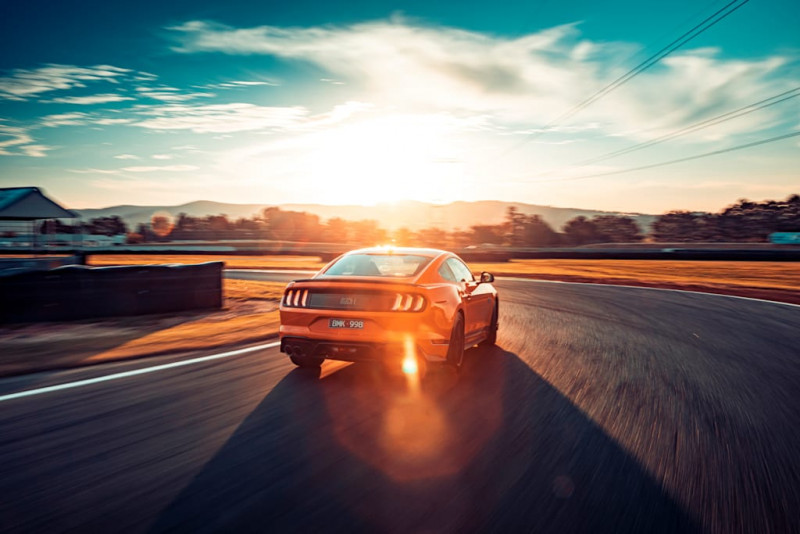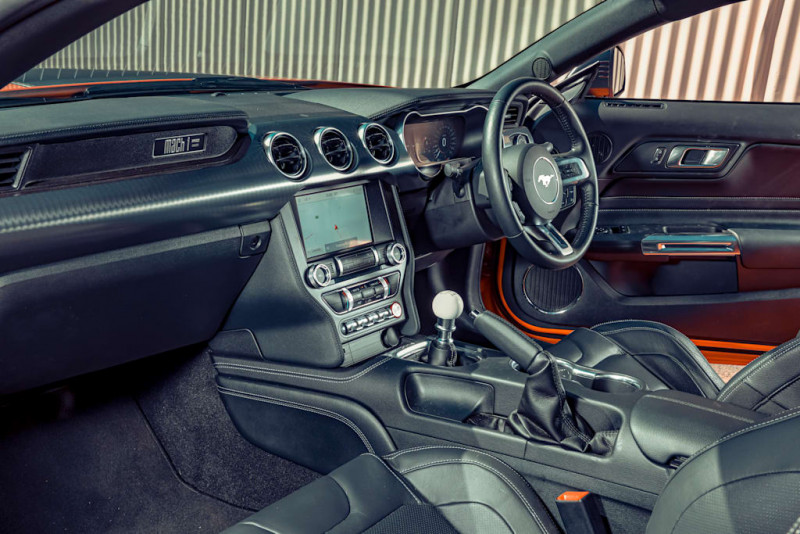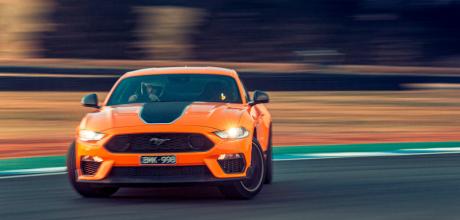2022 Ford Mustang Mach 1
Big Mach, hold the salad Just when you thought the Mustang was turning into an electric tribute act, along comes the track-targeted Mach 1
Woah! What’s going on? I’m pitching and rolling through the first turn in a car that’s meant to be track-ready. Swindle!
Ah. Hang on. I’ve forgotten to engage Track mode. Try again. And oh yes, here we go. This is much more like it – Track mode is certainly not a bit of marketing fluff. It sharpens the throttle, stiffens the MagneRide dampers and relaxes the stability control. And now let’s see what 454bhp of US V8 can do on this tight, demanding track in near-perfect conditions.


Wrangling it around a racetrack not your idea of what a Mustang’s all about? Fair enough – for most of us the Mustang is a distant rumour, somewhere between a living legend and a throwback that just won’t die. It’s only with the current (2015-on) generation that factory-built right-hand-drive Mustangs of any sort have been available, and this is the first ever Mach 1 to go on sale in the UK.
It arrives to form half of a Mustang line-up that is now just two models: this and the GT, both only offered in Fastback (hardtop coupe) form, both powered by 5.0-litre V8s. (Plus there’s the all-electric Mustang Mach-E line-up, also engineered by the same team that worked on the Mach 1, led by Matthias Tonn.) The differences are focused on making the Mach 1 better suited to track driving, where the current GT – quick, refined and comfortable on the road – needs help.

The GT’s auto ’box can barely last a lap at full noise and, while the manual has slightly more stamina (as in, two laps, maybe three), the gearing of the six-speed Getrag gearbox is so long that you’ll barely get into fourth at most tracks, with second gear stretching above 80mph and third beyond 120. This dulls the punch of the engine to such a degree that on the drag strip the manual is actually slightly slower than its less-powerful predecessor.
In the US, the obvious response to this is save up and buy a Shelby GT350 or 500, with more power and seriously tricked-up chassis, but that’s not an option for those of us wanting right-hand drive. However, Ford has revived a badge that fills the gap between the standard GT and flagship Shelbys. Mach 1 has been synonymous with sportier, more focused Mustangs since 1969, but it has been 17 years since the name was last used.
This ain’t no stripes ’n’ stickers pack, though the decals adorning the bonnet and sides – along with the Magnum-style wheels, new grille and rear diffuser with 4.5-inch tailpipes – certainly do the Mach 1’s looks no harm. It’s in the mechanicals, though, that things get really juicy. The induction system, intake manifold and 87mm throttle bodies from the Shelby GT350 give the V8 a 10bhp tickle to 454bhp and 390lb ft; the Shelby also donates its oil cooler, increasing cooling capability by 50 per cent.
The 19-inch wheels are a half-inch wider at both ends, and MagneRide adaptive dampers are fitted as standard (an option on the GT) and recalibrated, as is the power steering. There’s also a brake booster from the US-only Mustang Performance Pack 2, stiffer anti-roll bars and front springs, and bushes in the rear subframe, which also includes a toe-link from the GT500. The biggest change, however, regards what hangs off the back of the engine. Buyers can opt for a 10-speed automatic (for an extra £2000), which has been upgraded with a new torque converter, revised calibration and second oil cooler, while the manual as fitted to our test car is a totally different gearbox.
In place of the GT’s Getrag is the Tremec TR-3160 from the GT350, which uses different ratios. The Mach 1’s intermediate ratios are much more tightly stacked bar the overdrive sixth; don’t expect any improvement in 0-62mph sprint times, as first gear is actually taller than before, but on the move the new gearing bodes well for extracting more of the V8’s potential.
The car I’m driving at the Wakefield Park track in Australia is a prototype, but indistinguishable from the production version. It needs to answer two questions: is this a more capable, more enjoyable Mustang, and can it complete a number of consecutive laps without stress? The answer to both, happily, is yes. For a big, heavy car, the Mach 1 is relatively at home on track. It requires smooth inputs so as not to overload the tyres, and it rewards patience. The front end bites harder than a standard GT and some deft trail braking can adjust the rear.
However, the real win is the gearbox. It doesn’t just increase enjoyment by giving the driver more to do or improve performance by giving the engine a shorter ratio to pull; crucially, it also allows greater control over the Mach 1’s chassis. For example, through the tight turns one and eight I can use second for ultimate speed or, if the tyres are getting a little hot and loose, select third to calm the rear without sacrificing too much acceleration by falling down the rev range.
Through faster corners a standard GT would be languishing in third gear, any attempt to throttle-steer the car met with front-end push, whereas the Mach 1 is up on its toes thanks to its ability to over-speed the rear tyres.
With the ESP in its sportiest setting it will happily allow up to a half-turn of opposite lock before intervening, though ultimately the car is faster and more enjoyable with all the electronics off. What’s more, this fun now lasts longer than a couple of minutes, with the Mach 1 displaying no apparent thermal degradation despite consecutive full-throttle laps.
Over multiple sessions there isn’t one single drivetrain complaint and the brakes hold up incredibly well.
The regular GT should still be fine for those whose muscle car dreams are road-biased. It costs £11k less, makes only 10bhp less, and can be fitted with the MagneRide adaptive suspension that’s standard on the Mach 1.
First verdict
This is the Mustang if you’re serious about driving on track, expertly combining the most relevant bits from other ’Stangs ★★★★★
For a big, heavy car, the Mach 1 is relatively at home on track. The front end bites harder and deft trail braking can adjust the rear.
Interior unchanged, bar the Mach 1 badge complete with chassis number. Diffuser contributes to improved aero and houses four 4.5-inch tailpipes. Dial down the electronic intervention and the Mach 1 is nicely malleable.
TECHNICAL DATA 2022 Ford Mustang Mach 1
- PRICE £55,255
- POWERTRAIN 5038cc 32v V8, six-speed manual, rear-wheel drive
- PERFORMANCE 5/5
- MAX POWER 454bhp @ 7250rpm
- MAX TORQUE 390lb ft @ 4900rpm
- 0-62mph 4.8sec
- MAX SPEED 163mph
- WEIGHT 1743kg
- ON SALE 2021 Now
- EFFICIENCY 284g/km CO2
- ECONOMY 22.8mpg
The differences are focused on making a Mustang better suited to track driving, where the current GT needs help
THE FIRST HOUR
- 1 minutes Looks like it means business, with that new splitter and different wheels
- 2 minutes Little has changed inside – it’s a road car for the track, not a stripped-out racer
- 5 minutes Once I’ve actually remembered to engage Track mode, this feels seriously sorted
- 22 minutes Revised gear ratios are a revelation, making much better use of the power 58 minutes And, praise be: no overheating!
PLUS + New manual gearbox brings out the best in both engine and chassis
MINUS — Still big and heavy; road drivers should stick with a GT


